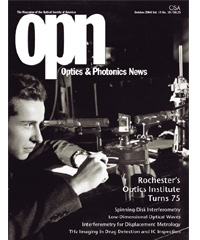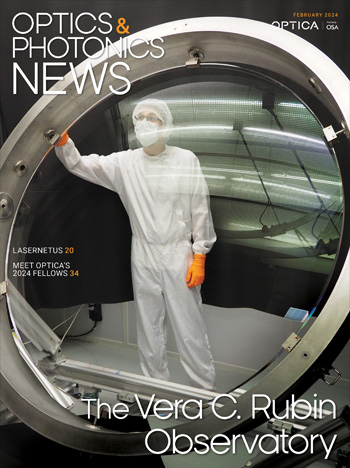
October 2004 Issue
Feature Articles
Rochester’s Optics Institute Turns 75
The University of Rochester’s Institute of Optics opened its doors in 1929. In the intervening 75 years, it has trained generations of professionals specialized in the techniques and materials on which modern optics is based. A groundbreaking ceremony for the institute’s new building will coincide with Frontiers in Optics, OSA’s 88th Annual Meeting.
by Kim DouglassTerahertz Imaging For Drug Detection And Large-Scale Integrated Circuit Inspection
Until fairly recently, the terahertz range was considered little more than the dark gap that separated the two halves of the electromagnetic spectrum. Now scientists have come to view it as a bridge rife with possibilities for new applications and research.
by Kodo KawaseInterferometry for Accurate Displacement Metrology
The most accurate measurements of displacements are made with optical interferometry. The author discusses a quadruple heterodyne Michelson interferometer for active position control and the use of Fabry-Pérot interferometry for displacements of up to 50 mm.
by John LawallSpinning-Disk Interferometry: The BioCD
High speed interferometry on a spinning disk opens new opportunities for sensitive material metrology. A promising new application is fast molecular screening in diagnostic medicine.
by David D. Nolte and Fred E. RegnierLow-Dimensional Optical Waves And Nano-Optical Circuits
Optical waves with one or two dimensions can be used to create nanowaveguides that could ultimately find application in nano-optical circuits.
by David D. Nolte and Fred E. Regnier David D. Nolte and Fred E. RegnierDepartments and Columns
Early Ion Laser Development
In the third installment of OPN’s column on the development of lasers, scientist Steven Jarrett describes his experiences as a co-founder of Coherent Inc. at a time when the company was working to develop carbon-dioxide and ion lasers.
Duke University: Educating Engineers for the International Photonics Community
As the year 2000 wound down, Duke University’s Pratt School of Engineering was gearing up to launch an aggressive new program in photonics research and education. Four years later, the vision of an undergraduate- to-graduate education that positions students to enter the international photonics community is becoming a reality.
Claudius Ptolemy’s Law of Refraction
I was amazed to discover that mathematician, astronomer and physicist Claudius Ptolemy had already performed a series of careful experiments in the first century C.E. to determine the rules of refraction.
"Hands-On Optics" Tackles Science Illiteracy
In response to rising concern about science illiteracy in the United States, OSA and SPIE have launched a new program, “Hands-On Optics,” which targets middle school students. It is designed to inspire an interest in technology by bringing optics-related activities into after-school and other extracurricular science programs.
Should You Patent Your Invention Or Keep It a Trade Secret?
A company may seek to patent an innovation or it may believe it has a competitive advantage in not disclosing it to the public and keeping it a trade secret. Here we explain how to protect an innovation as either a patent or a trade secret.

![A multiplexed image of a human tonsil acquired. [NIAID] using the iterative bleaching extends multiplexity (IBEX) method.](https://opnmedia.blob.core.windows.net/$web/opn/media/images/articles/2024/0424/departments/202404-cover-web.jpg?ext=.jpg)

